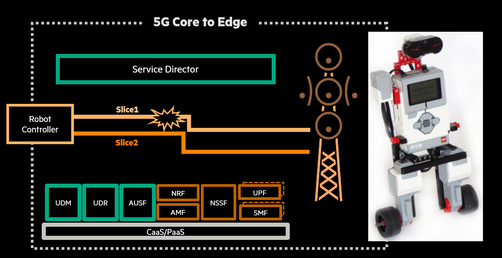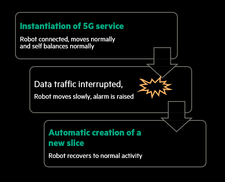- Community Home
- >
- Solutions
- >
- Tech Insights
- >
- At Orange Labs, Automated 5G Network Slicing Start...
Categories
Company
Local Language
Forums
Discussions
Forums
- Data Protection and Retention
- Entry Storage Systems
- Legacy
- Midrange and Enterprise Storage
- Storage Networking
- HPE Nimble Storage
Discussions
Discussions
Discussions
Forums
Discussions
Discussion Boards
Discussion Boards
Discussion Boards
Discussion Boards
- BladeSystem Infrastructure and Application Solutions
- Appliance Servers
- Alpha Servers
- BackOffice Products
- Internet Products
- HPE 9000 and HPE e3000 Servers
- Networking
- Netservers
- Secure OS Software for Linux
- Server Management (Insight Manager 7)
- Windows Server 2003
- Operating System - Tru64 Unix
- ProLiant Deployment and Provisioning
- Linux-Based Community / Regional
- Microsoft System Center Integration
Discussion Boards
Discussion Boards
Discussion Boards
Discussion Boards
Discussion Boards
Discussion Boards
Discussion Boards
Discussion Boards
Discussion Boards
Discussion Boards
Discussion Boards
Discussion Boards
Discussion Boards
Discussion Boards
Discussion Boards
Discussion Boards
Discussion Boards
Discussion Boards
Discussion Boards
Community
Resources
Forums
Blogs
- Subscribe to RSS Feed
- Mark as New
- Mark as Read
- Bookmark
- Receive email notifications
- Printer Friendly Page
- Report Inappropriate Content
At Orange Labs, Automated 5G Network Slicing Starts Now
Of all the new innovations 5G brings to mobile networks, none excites operators more than network slicing. Since the earliest cellular networks, there’s been basically just one kind of mobile service, limiting what enterprise customers could do with mobile connectivity—and the ways telcos could differentiate it. Network slicing turns that status quo on its head.
For the first time, mobile operators can slice up their networks into specialized sub-networks, each tuned to the unique needs of a specific service, application, or vertical. For example, one slice could be optimized for low-bandwidth, low-power-consumption Internet of Things (IoT) devices like sensors or power meters. Another could be dedicated to 4K video streaming. Still, another could be tuned for ultra-low latency communication with industrial equipment in a Smart Factory.
Start listing possibilities, and you can paint an amazing picture of what operators can do with 5G networks. But, you’re describing capabilities that go beyond what networks can support today. It’s natural to assume we’re talking about the distant future.
Well, get ready, because the future starts now.
HPE recently partnered with Orange Labs and Casa Systems to demonstrate what open, automated network slicing can look like in the real world. And here’s the best part: you don’t have to read through arcane technical reports to get the results. You can see them with your own eyes, in real-time.
Building tomorrow’s 5G services
If your goal is just to showcase a narrow 5G test case, it’s not hard to set up a proof-of-concept to do just that. HPE, and our partners at Orange Labs and Casa Systems, had more ambitious plans. We wanted to demonstrate slicing in a system that met the same kinds of requirements carriers will face in real-world networks. The test network had to be:
Open and multi-vendor interoperable. You can’t expect to support diverse vertical applications if everything you use has to come from one supplier. Operators need to be able to integrate 5G technology from multiple vendors, within a single framework.
Automated end-to-end. Splitting a network into slices inherently adds complexity. Relying on manual configurations for all the technologies in the service path of each slice won’t work. You should be able to define what you need in a high-level orchestrator and have the network automatically instantiate the end-to-end slice, from the core through the RAN.
Elastically scalable. To monetize network slicing, you need to be able to guarantee those unique slice attributes under service-level agreements (SLAs). That means the network has to support closed-loop automation—adding resources to a slice or instantiating a new one in real-time to preserve SLAs when network conditions deteriorate.
It’s a tall order, but 5G operators can’t deliver network slices, much less monetize them, without those pieces in place. As we demonstrated in the video, these capabilities are not just science fiction. The tools for implementing open 5G network slicing exist right now.
Inside the Demo
In the video above, you can see the complete, cloud-native 5G test network we assembled at Orange Labs, using solutions from HPE and Casa Systems. 
To simulate a mission-critical application, we chose a scenario that could easily be part of an operator’s portfolio: controlling a robot over a 5G network. This also allowed us to showcase network slicing in a way where it would be easy to see how it worked—or didn’t.
In the test, a small kit robot roams around a room, controlled by a remote operator over the 5G network. We then flooded the network with congestion. As you’d expect, the robot slowed down, clearly lagging in its response to commands. As soon 
Welcome to the 5G Future
Think of everything happening “under the hood” in this test: Location-based telemetry. Low-latency network slicing. Edge computing.
The test environment also addressed all the key requirements real-world 5G networks have to meet. This was a truly open, multi-vendor network, using cloud-native network functions from HPE and Casa Systems. It allowed Orange to configure a network slice end-to-end through HPE Service Director. And, it performed true closed-loop automation, dynamically responding to deteriorating network conditions to preserve an SLA.
This demo was, ultimately, a demo, not a live network serving real telco customers. But it should erase any doubts you might have about network slicing in open, multi-vendor environments: It’s real. It’s viable. And, it’s coming soon to a 5G network near you.
Interested to learn more about the architecture behind this? read our new white paper: Reimagining Core Networks, our visit our 5G knowledge sharing page: HPE.com/info/5G
- Back to Blog
- Newer Article
- Older Article
- Amy Saunders on: Smart buildings and the future of automation
- Sandeep Pendharkar on: From rainbows and unicorns to real recognition of ...
- Anni1 on: Modern use cases for video analytics
- Terry Hughes on: CuBE Packaging improves manufacturing productivity...
- Sarah Leslie on: IoT in The Post-Digital Era is Upon Us — Are You R...
- Marty Poniatowski on: Seamlessly scaling HPC and AI initiatives with HPE...
- Sabine Sauter on: 2018 AI review: A year of innovation
- Innovation Champ on: How the Internet of Things Is Cultivating a New Vi...
- Bestvela on: Unleash the power of the cloud, right at your edge...
- Balconycrops on: HPE at Mobile World Congress: Creating a better fu...
-
5G
2 -
Artificial Intelligence
101 -
business continuity
1 -
climate change
1 -
cyber resilience
1 -
cyberresilience
1 -
cybersecurity
1 -
Edge and IoT
97 -
HPE GreenLake
1 -
resilience
1 -
security
1 -
Telco
108


